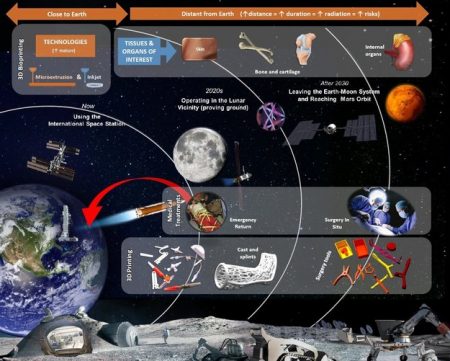December 18, 2018 – One of the more intriguing stories that showed up in the last week came out of the European Space Research and Technology Centre in The Netherlands from a two-day ESA workshop at which bioprinting experts discussed using the technology and regenerative medicine for future space missions.
ESA has been working on health and survivability issues for astronauts going on Deep Space missions. Whereas an astronaut or cosmonaut on the International Space Station can return to Earth in the event of an onboard medical emergency, those undergoing long-duration missions to the Moon, Mars, or a future asteroid visit will be too far away for medical intervention in the face of a serious injury.
ESA is also looking at bioprinting and regenerative medicine as a means to counter the effects of prolonged exposure to cosmic radiation, and to the physiological impacts to the body in low-gravity environments such as Mars and the Moon. The idea is to be able to print skin, bones, and organs.
The missions ESA is evaluating for the use of bioprinting and regenerative technologies are long-duration including journeys to the Moon with stays lasting weeks or months, or an exploratory mission to Mars with human crews in interplanetary space for six months or more en route and on the surface of the planet for a month or more.
Among the materials that the ESA researchers are studying are hydrogels which are thermoplastic polyurethanes that can create scaffolding to repair and regenerate load-bearing soft tissues like cartilage, tendons, and blood vessels. Hydrogels are great for regenerative medicine because they can be easily extruded through a 3D printer, and are water friendly which makes them a perfect medium for restoring and regenerating soft tissues.
The use of 3D bioprinting today is still at the early stages of development. Today the best that 3D printers can do is manufacture prosthetics for legs and arms, create laboratory-generated tissues that have the characteristics of human organs on a minuscule scale, and build accurate models of bone and tissue that surgeons can study prior to doing complex procedures. These 3D printers get their data from diagnostic imaging technologies which render digital images and data that can be interpreted. But it takes considerable time to render the digital images into detailed printing instructions, sometimes days. So the next advancement to get to where ESA wants to go is to take computer-generated radiology images of bones, blood vessels, and organs and using software generate precise printing instructions in a matter of minutes once an injury has been assessed.
Of course, what ESA wants to deliver in Deep Space will have profound and meaningful use here on Earth. The field of replacement therapy and regenerative medicine using 3D bioprinting will alter how medicine is practiced. Imagine replacing a defective kidney with a healthy 3D printed one ending the need for dialysis. Or replacing defective hearts, lungs, livers, bladders, ovaries, uteruses, pancreases and other body parts eliminating much of what medicine has to treat today.
When will 3D bioprinting of replacement body tissue become a reality? Sometime within the next decade believe the experts in this very new technological field.









